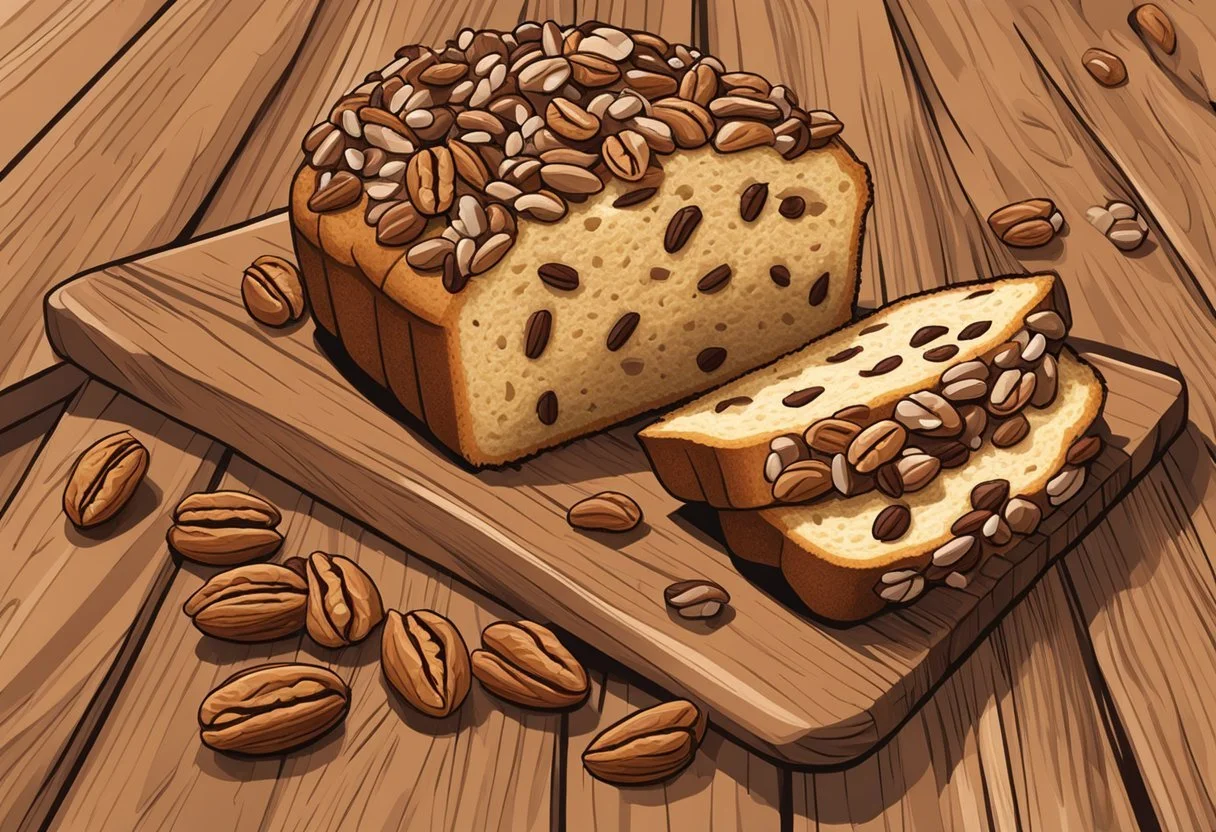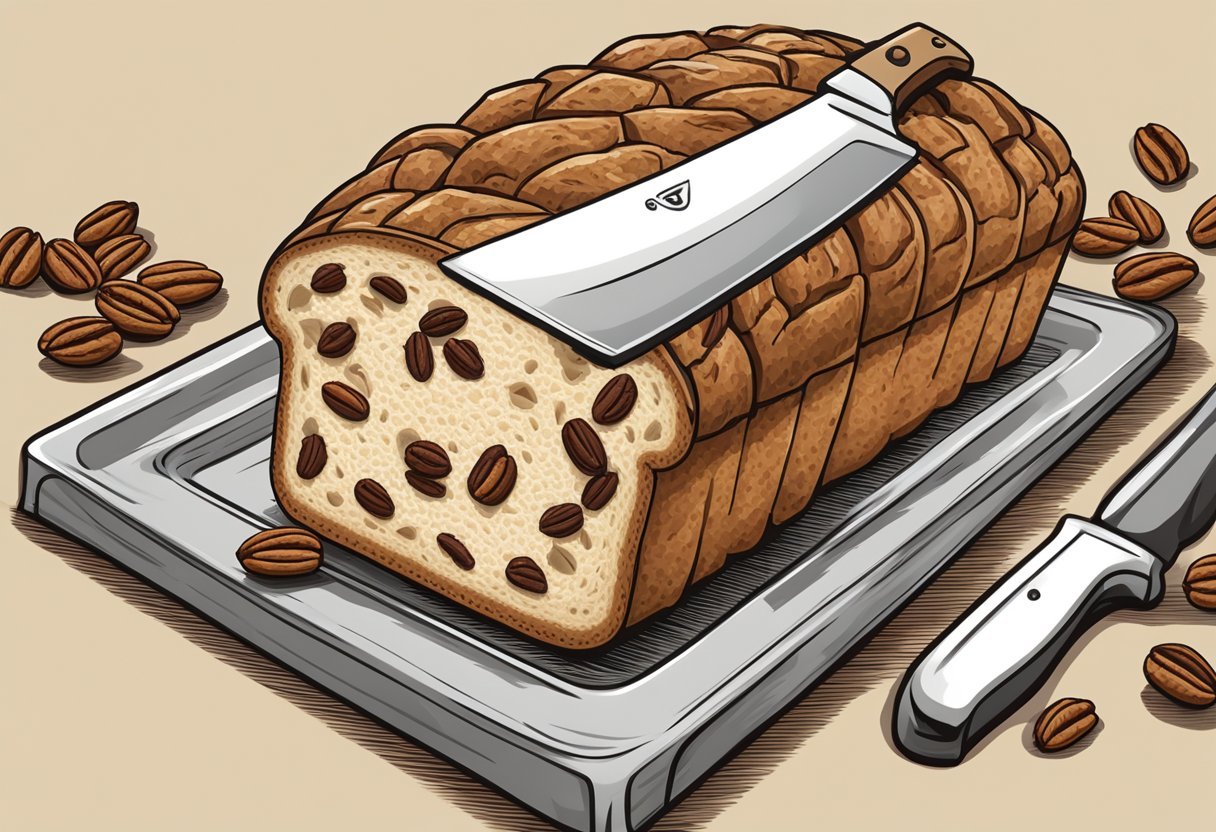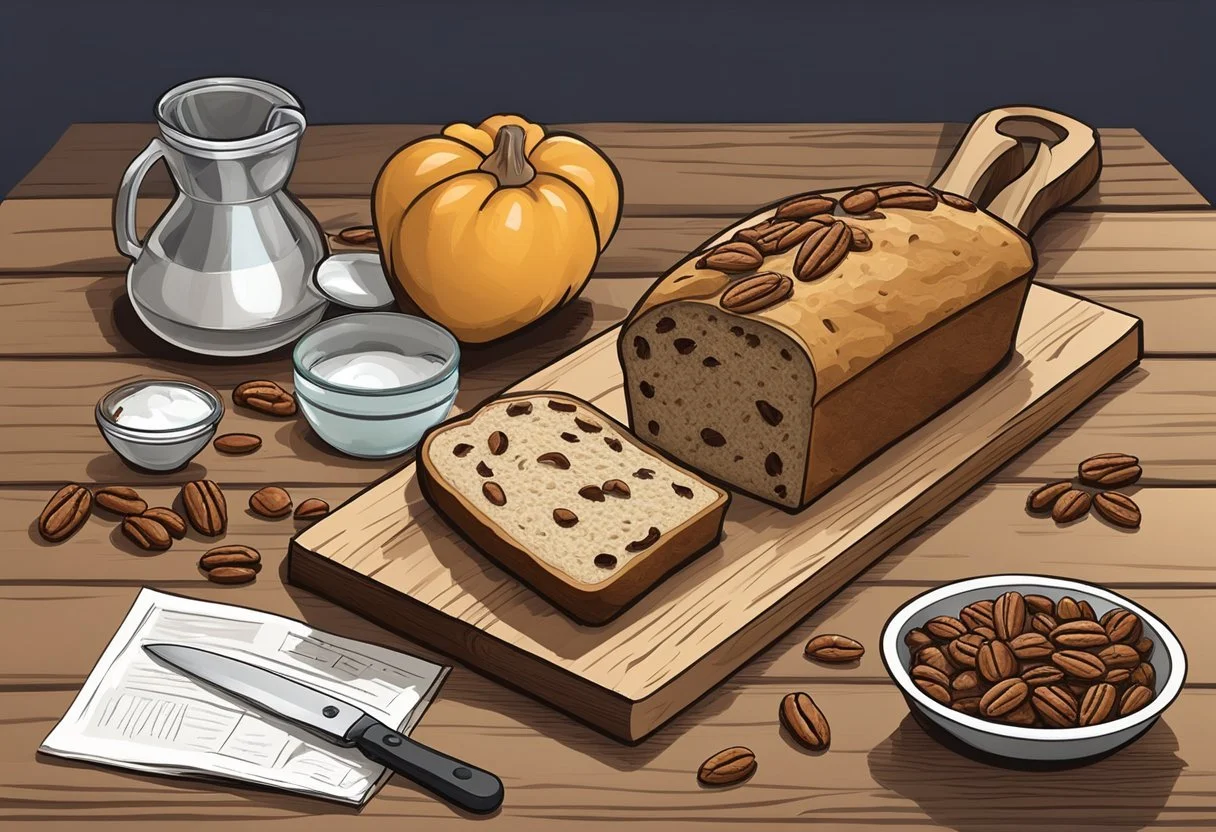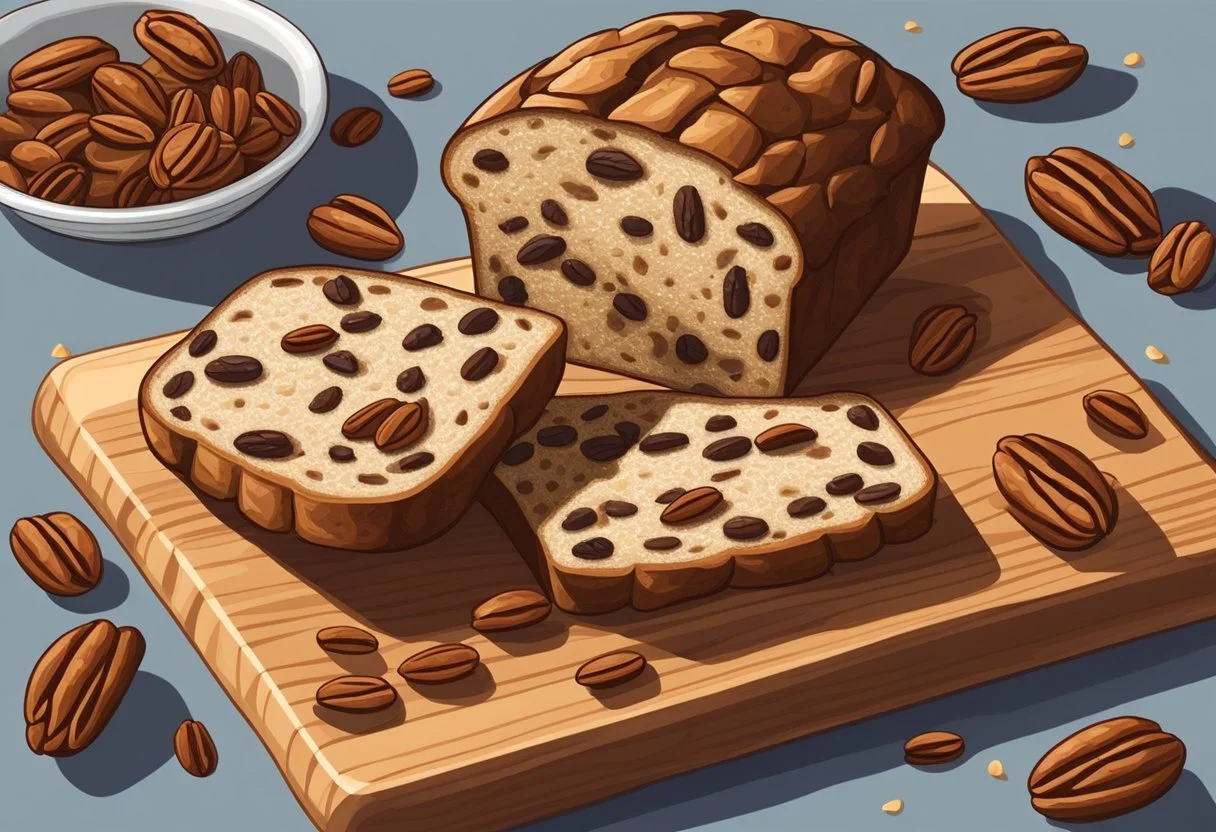Texas Pecan Raisin Bread
A Delicious and Nutritious Treat to Savor
Discover > Truly Texan > Texas Pecan Raisin Bread
Texas Pecan Raisin Bread is a delightful combination of flavors that can quickly become the taste of home for many. This delicious bread is packed with the nuttiness of Texas pecans (how long do pecans last?) and the natural sweetness of raisins (how long do raisins last?), creating a perfect balance of taste and texture. Not only does this bread recipe showcase the best of what Texas has to offer, but it also celebrates the homemade, comforting essence of a family kitchen.
The unique flavor profile of this bread can be attributed to both the high-quality pecans, which are widely produced in the state, and the juicy raisins that add a burst of sweetness to every bite. When combined, these ingredients elevate the humble bread into a true culinary experience, encapsulating everything that people love about Texas' diverse food culture.
Creating this bread from scratch can be an enjoyable and satisfying experience for even the most novice of bakers. With a confident approach and the right guidance, anyone can indulge in the fantastic flavors of a Raisin Pecan Bread recipe. This exquisite creation is the embodiment of a well-loved home-cooked treat, perfect for sharing with family and friends or savoring alone.
The History of Texas Pecan Raisin Bread
The Texas Raisin Pecan Bread recipe has its roots firmly planted in the Lone Star State. This satisfying and delightful bread combines the nutty crunchiness of pecans with the sweet and chewy texture of raisins, making it an ideal treat for breakfast or as a snack.
The origin of Texas Pecan Bread can be traced back to the early settlers in Texas who used locally grown ingredients to create various dishes. Pecans, native to the region, were a staple food for the native tribes, and later became an integral part of Texan cuisine. Raisins, on the other hand, were introduced by Spanish settlers and missionaries who brought grapevines to cultivate in the region.
A key factor in the development of this bread was the widespread availability of ingredients. As the pecan industry flourished in Texas, particularly in the central and eastern parts, it became an obvious choice for baking breads, cakes, and cookies. Meanwhile, the cultivation of grapes for raisins was gaining popularity in the state, thanks to its suitable climate.
Over time, Texas Pecan artisan bread evolved as home bakers experimented with these local ingredients, creating a perfect blend of flavors and textures. As a result, this artisan bread gained widespread recognition and became an emblematic part of Texan cuisine.
Here's a brief timeline of notable events related to Texas Pecan Bread:
In conclusion, the history of Texas Pecan Bread is rooted in the fusion of two key ingredients native to the region: pecans and raisins. The unique blend of flavors and textures made this artisan bread a popular choice among Texans, and its rich history has cemented its place in Texan cuisine. Today, it continues to hold an esteemed position on the tables of local bakeries and homes alike.
Nutritional Profile
Caloric Content
Texas Pecan Bread is a delicious treat that provides a moderate amount of calories. A single serving (about 100 grams) contains approximately 280-320 calories. As with any food, consuming it in moderation is key to maintaining a balanced diet.
Macronutrients
The macronutrients in Texas Pecan Bread contribute to its satisfying taste and texture. Here is a breakdown of the macronutrients per 100g serving:
Fats in this raisin bread mainly come from pecans, which are a source of healthy unsaturated fats. The small amount of saturated fat is mainly from butter or other dairy products used in the recipe.
Carbohydrates are mainly derived from the flour (how long does flour last?) and raisins. Flour provides starch, while raisins contribute natural sugars (how long does sugar last?). The fiber content in Texas Pecan artisan bread is relatively low, but it still offers a small contribution to your daily requirements.
The modest protein content comes from the combination of flour and pecans in the recipe.
Vitamins and Minerals
Texas Pecan Bread offers a variety of vitamins and minerals that contribute to a balanced diet. Notable vitamins and minerals found in the raisin bread include:
Iron: Found in the flour and raisins, this essential mineral is necessary for the production of red blood cells.
Calcium: Present in the dairy products used in the recipe, calcium is important for maintaining healthy bones and teeth.
B Vitamins: These vitamins, particularly B1 (thiamine) and B2 (riboflavin), can be found in flour and pecans. B vitamins contribute to healthy metabolism and energy production.
It is important to note that while Texas Pecan Bread does provide some nutritional benefits, it should be enjoyed as part of a balanced and varied diet, along with other sources of vitamins and minerals.
Ingredient Breakdown
Flour Types
When it comes to Texas Pecan Bread there are numerous delicious recipes, the two most commonly used flours are bread flour (how long does bread flour last?) and all-purpose flour. Bread flour provides a higher protein content, resulting in a stronger gluten structure for a chewier texture. On the other hand, all-purpose flour yields a slightly softer, tender loaf. For the perfect balance, one can try a combination of both flours.
Make your life easier by ordering bread flour and all-purpose flour online; it's just a few clicks away!
Sweeteners
A variety of sweeteners can be used in the Pecan Raisin Bread. Sugar and honey (how long does honey last?) are popular choices that add sweetness without overpowering the other flavors. Using honey also contributes a touch of floral notes that complement the nutty taste of the artisan bread.
Sugar: 1/2 cup
Honey: 1/4 cup
Avoid the crowds and shop for sugar and honey online from the comfort of your home!
Nuts Variation
For the bread's signature nutty flavor, many delicious recipes make pecans the star ingredient. However, one can also incorporate different nuts (how long do nuts last?) to suit personal preferences or for added texture. Walnuts (how long do walnuts last?) are another popular option that pairs well with the sweetness from the raisins. Here is a breakdown of the nuts used:
The raisin bread also features raisins and golden raisins, which contribute to its natural sweetness. Using a mix of both types adds more dimensions to the final product.
Yeast and Rising Agents
To achieve the perfect rise and texture, active dry yeast (how long does active dry yeast last?) is commonly used in Texas Pecan artisan bread. This type of yeast needs to be bloomed, or activated, in warm water before being added to the dough. For best results, follow the package directions and allow the dough to rise in a warm, draft-free area.
Experience the convenience and savings of buying active dry yeast online!
Baking Instructions
Preparing the Dough
To begin the bread making, gather the following ingredients to make the dough for your Texas Raisin Bread recipe:
4 cups all-purpose flour
1/3 cup white or brown sugar - if using brown sugar use a light one
1 teaspoon salt
2 1/4 teaspoons active dry yeast
1 1/2 cups warm water
2 tablespoons vegetable oil (how long does vegetable oil last?)
1 cup raisins
1 cup chopped pecans
In a large bowl, combine the flour, brown sugar, salt, and instant yeast (how long does instant yeast last?) with a wooden spoon. Gradually add the warm water and vegetable oil to the dry mixture while stirring with a wooden spoon to combine. It will become difficult to stir with a wooden spoon, so once the dough comes together, transfer it to a lightly floured surface and knead bread for 8-10 minutes. As you gradually knead bread the dough should become smooth and elastic in texture. This is the first part of the bread-making process.
Next, gently fold in the raisins and chopped pecans, ensuring that they are evenly distributed throughout the dough.
Online stores offer unbeatable prices for vegetable oil, raisins, mixing bowl, and wooden spoon, so don't miss out!
Proofing and Rising
Once the dough is prepared, place it in a greased bowl and cover with a damp cloth or plastic wrap. Allow the dough to rise for 1 to 1.5 hours or until it has doubled in size.
During this part of the bread making process, the yeast will ferment, encouraging the development of texture and flavor in the raisin bread.
Bread Baking the Raisin Pecan Loaf
After the dough has risen it's ready for bread baking. Preheat your oven to 375°F (190°C). While the oven is heating, punch down the dough to release any air bubbles and transfer it to a lightly floured surface. Knead bread gently to shape it into a round or oval loaf, and gently score the top with a sharp knife, making a few shallow slashes.
Transfer dough of raisin pecan loaf onto a parchment-lined baking sheet and let it rest for about 20 minutes before baking. This allows the dough to rise slightly and will result in a better crust during bread baking.
Bake the raisin bread for 35-40 minutes, or until the crust is golden brown and the loaf sounds hollow when tapped. The top crust should be golden brown and the sides and base lighter brown. Remove the Raisin Pecan bread from the oven and let it cool on a wire rack before you serve your delicious Texas Pecan Bread. Enjoy!
Discover the endless possibilities of buying parchment paper and baking sheet online!
Special Techniques and Tips
Kneading Methods
Kneading the dough is a crucial step in the bread making process Pecan Raisin Bread. There are different techniques to ensure the dough develops the right texture and elasticity. Here are some methods to choose from:
Hand kneading: This traditional method involves working the dough with your hands on a clean, floured surface. Fold, press, and roll the dough until it becomes smooth and elastic.
Stand mixer with dough hook: For those who prefer a hands-free approach, a stand mixer fitted with a dough hook attachment can do the kneading for you. Mix on low speed until the dough forms a smooth and elastic ball.
Allow the Raisin Pecan dough rest for about 10-15 minutes after kneading in a lightly greased bowl . This helps the gluten relax, the dough rise and makes shaping the loaf easier.
Preventing Sticking
To prevent the dough from sticking to surfaces and the pan, take some precautions:
Always flour your work surface and hands before handling the dough. This will create a barrier between the dough and any surface it touches.
Line your loaf pan with parchment paper, as it's non-stick and facilitates easy removal of the raisin bread after baking. Spray the inside surface of the parchment paper very lightly with oil. The combination of parchment paper and oil will ensure the bread comes away cleanly.
Spray the inside surface of the parchment paper very lightly with oil. Then lightly dust the parchment paper or the bottom of the pan with cornmeal (how long does cornmeal last?). The cornmeal will stick to the parchment paper making an extra barrier. This adds extra insurance against sticking and also imparts a nice texture to the bottom crust.
Achieving Perfect Crust
The ideal Texas Pecan Bread has a golden-brown crust with a tender, yet slightly crunchy texture. Here are some tips to achieve that perfect crust:
Preheat your oven thoroughly before baking the raisin bread. A hot oven will help to achieve a nice crust and even baking.
To promote an even browning, rotate the baking bread halfway through baking.
To prevent overbrowning or burning, tent the baking bread with foil if the crust starts getting too dark.
After baking, transfer the raisin bread to a wire rack to cool completely. Remove all the parchment paper. This allows proper air circulation and prevents the crust from becoming soggy due to trapped steam and leaves you with a gorgeous loaf.
Serving and Pairing Suggestions
Texas Pecan Bread can be enjoyed in a variety of ways. This versatile raisin bread can be served at any time of the day – breakfast, brunch (What wine goes well with brunch?), or as a dessert. Here are some serving and pairing suggestions to make the most of this delicious raisin bread.
For a breakfast or brunch option, consider the following:
Cut loaf with a sharp knife and toast the bread and spread a layer of cream cheese on top for a delightful balance of sweet and tangy flavors.
Serve the raisin bread with a side of fresh fruit to complement the sweetness of the raisins and pecans.
Pair it with your favorite tea or coffee for a comforting and fulfilling start to your day.
Transforming the Texas Raisin Pecan Bread into a dessert is also an appealing way to serve it:
Warm the bread slightly and top it with a scoop of vanilla ice cream for a truly indulgent treat.
Drizzle the bread with a caramel sauce to enhance the flavor of the raisins and pecans.
In terms of wine pairings, consider the following:
A sweet dessert wine, such as a late harvest Riesling or Moscato, can complement the fruity notes of the raisins.
A fortified wine, like Port or Sherry, can add an extra layer of richness that pairs well with the nutty pecans.
Feel free to get creative and experiment with various serving styles and pairings to discover your personal favorite way to enjoy the delightful flavors of Texas Pecan Bread.
Storage and Preservation
Countertop Storage
Texas Pecan Bread can be stored on the countertop for short-term consumption. After the bread cools, wrap it in a plastic wrap, foil or parchment paper to keep it fresh and retain its moisture. However, it is essential to ensure that it is properly sealed to prevent it from becoming stale. Place the wrapped bread in a bread box or container with a tight-fitting lid.
It is important to note that the optimal time to enjoy the Raisin Pecan bread for its freshness and flavor is within 2-3 days of baking. Also, consider storing the bread in a cool, dry place away from direct sunlight.
Freezing and Reheating
For long-term storage, freezing Texas Raisin Pecan Bread is an excellent option. Before freezing, allow the bread to cool completely. Then, follow these simple steps:
Wrap the entire loaf or individual slices in plastic wrap, foil or parchment paper. Double wrapping is recommended to preserve the bread's quality and prevent freezer burn.
Place the wrapped loaf or slices in a plastic freezer bag. Make sure to remove the excess air, and securely seal the bag.
Label the bag with the date, and place it in the freezer. The bread can be stored in the freezer for up to 3 months.
To reheat the bread, remove it from the freezer bag and unwrap it. If heating the entire loaf, wrap it in foil, and place it in a preheated oven at 350°F for approximately 20-25 minutes, or until warmed through. For individual slices, a toaster or toaster oven works well.
Bread Machine Adaptation
Adapting the Texas Pecan Bread recipe for a bread machine is fairly simple. Follow the steps below to achieve the perfect loaf using this convenient kitchen appliance.
Bread Machine Settings: Choose the basic bread setting on your bread machine, as this will generally work well for most bread recipes, including Texas Pecan Bread. Be sure to consult your bread machine's manual to familiarize yourself with specific settings and requirements, especially when the dough rise.
Crust Color: Select your preferred crust color setting. A medium setting is recommended, as it will give your Pecan Bread a nice balance between a soft and crispy crust.
Loaf Size: It's important to adjust the loaf size setting on the bread machine to match the amount of ingredients in the recipe. Most bread machines will have options for 1, 1.5, or 2-pound loaves. Choose the appropriate size based on the recipe you're using.
Bread Machine Directions:
Add all liquid ingredients (water, milk, oil, honey, etc.) to the bread machine pan. This will help to ensure that the dry ingredients don't stick to the bottom of the pan.
Mix the dry ingredients (flour, sugar, salt, etc.) in a separate bowl, making sure to evenly distribute the yeast. Carefully add the dry mixture to the liquid ingredients in the bread machine.
Next, add the pecans and raisins to the bread machine, making sure they are evenly spread throughout the dough.
Close the lid and start the bread machine on the aforementioned settings. The bread machine will handle all the mixing, kneading, proofing, and baking steps.
By following these simple steps and suggested settings, you'll be able to enjoy a delicious Texas Pecan Bread without the need for any manual kneading or baking. The bread machine makes the process effortless, ensuring consistent fresh bread results every time.
Troubleshooting Common Issues
Dough Consistency Problems
Achieving the perfect dough consistency can be challenging, but it is essential for a delicious Texas Pecan Bread. Here are some common issues and solutions:
Too Sticky: If the dough is too sticky, it may be difficult to knead and shape. To remedy this, add a small amount of flour, a tablespoon at a time, until the dough reaches the desired consistency.
Too Dry: A dry dough can result in a dense and crumbly final product. To fix this, add water, a tablespoon at a time, until the dough is more manageable.
Yeast Activation: Ensure that the yeast is activated properly by checking for bubbles and a strong yeast smell after it has been dissolved in warm water. If the yeast does not activate, it may be expired and should be replaced.
Baking Anomalies
There can be various concerns that arise during the baking process. Here are some common anomalies and their solutions:
Uneven Rise: If the Texas Pecan Bread does not rise evenly, it may be due to insufficient kneading or uneven distribution of ingredients. To avoid this, ensure thorough kneading and evenly spread the add-ins like pecans and raisins.
Too Dark: If the bread becomes too dark, it may be due to an oven temperature that is too high. Use an oven thermometer to make sure when you preheat oven it's at the correct temperature before you bake bread, and if necessary, adjust accordingly.
Undercooked Center: An undercooked center can result from a too-short baking time or an oven temperature that is too low. To avoid this issue, check for doneness using a toothpick inserted in the center of the bread. If it comes out clean, the bread is done. If not, continue baking and check again in a few minutes.
By addressing these common issues, your Texas Pecan Bread will achieve the desired texture and taste every time.
Variations of the Recipe
Different Nut Incorporations
One of the pleasures of making raisin pecan bread is experimenting with different nut incorporations. While the traditional recipe calls for pecans, you can also substitute them with other nuts such as walnuts, almonds (how long do almonds last?), or even macadamia nuts. Mixing a variety of nuts in the dough can also add an interesting twist. Feel free to try the following combinations:
50% pecan and 50% walnut
30% pecan, 30% almond, and 40% walnut
40% pecan and 60% macadamia nuts
When making substitutions, keep in mind that each nut imparts its unique flavor, so consider how the combination will taste.
Alternate Sweeteners
Various sweeteners can enhance the flavor of your homemade bread. Honey is an excellent alternative to traditional sugars, providing a natural sweetness as well as health benefits. Substitute the same amount of honey with sugar in the recipe. Similarly, rich maple syrup (how long does maple syrup last?) can be a delicious twist to the recipe, enhancing the bread with a delightful caramel undertone.
For a healthier option, reduce the sugar content by using natural sweeteners like stevia or monk fruit. The subtle sweetness from these substitutes maintains the integrity of the bread without adding extra calories. Remember to adjust quantities according to the sweetener's manufacturer's recommendations.
Gluten-Free Versions
For individuals with gluten intolerance or celiac disease, gluten-free flour can easily replace all-purpose flour. Keep an eye out for gluten-free baking mixes that contain xanthan gum (how long does xanthan gum last?), which helps improve the bread's texture without compromising taste. Alternatively, you can use the following gluten-free flour blend:
Creating a gluten-free raisin pecan bread does not mean sacrificing flavor. Add a touch of cinnamon and a dash of sea salt (how long does sea salt last?) or kosher salt (how long does kosher salt last?) to enhance the taste and showcase the pecans' natural richness. Regardless of your ingredient choices, the art of baking a delicious pecan bread lies in the careful balance of flavors and textures.
FAQs and Expert Tips
Q: How do I store Texas Pecan Bread to keep it fresh?
Tip: Store the homemade bread in an airtight container or plastic wrap at room temperature for up to 3 days. To maintain its freshness longer, freeze it for up to a month.
Q: Can I substitute other nuts for pecans?
Expert Advice: Yes, you can experiment with other nuts like walnuts or almonds. Keep in mind that this will alter the classic Texas Pecan Bread flavor.
Q: My bread turned out dry. What went wrong?
Troubleshooting: The most common reason for dry bread is overbaking. Ensure that you follow the recommended baking time and monitor the oven temperature closely. Another possible issue is not enough moisture in the dough itself, so double check the liquid ingredients.
Q: How can I make sure my raisins are evenly distributed throughout the bread? Expert Advice: Soak the raisins in warm water for about 10 minutes to soften them. Then, drain and dry them before folding into the dough. This process will make it easier to evenly distribute the raisins without tearing the dough.
Some expert tips for the perfect Texas Pecan Bread:
Accuracy is key. Measure the dry ingredients correctly, as too much or too little flour can greatly affect the bread's texture.
Choose the right type of yeast. Instant yeast is preferable for this recipe, as it does not require any activation and can be mixed directly with the dry ingredients.
Test the dough's consistency. The dough should be slightly sticky, but not overly wet. If it's too dry, add a tablespoon of water; if it's too wet, add a tablespoon of flour.
By following these questions, troubleshooting tips, and expert advice, you're well on your way to creating a delicious Texas Pecan Bread.
Conclusion
Texas Pecan Bread is a delightful addition to any family gathering or meal. Its unique flavor combination of rich pecans and sweet raisins creates a satisfying experience that can be enjoyed by people of all ages.
Flavor: The homemade bread boasts a perfect balance of nutty pecans and sweet raisins, complemented by a touch of cinnamon and brown sugar. The brown sugar adds caramel flavors and the cinnamon pairs well with the fruit and nuts. There are comparisons between Pecan Bread and a Cinnamon raisin bread recipe.
Family: Sharing a freshly baked loaf of Texas Pecan homemade bread can bring loved ones together, creating delightful memories. Its versatile nature allows it to be served as a centerpiece during special occasions or as a simple snack during family gatherings.
Texas Pecan Bread's ability to satisfy both sweet and savory taste preferences ensures a positive experience for everyone who tries it. Its inviting aroma entices the senses, instantly creating an enjoyable atmosphere wherever it is served.
In summary, Texas Pecan Raisin Homemade Bread offers a unique, flavorful, and satisfying experience that is perfect for sharing with family and friends. Its delightful taste, versatile nature, and connection to family events make it a must-try for anyone seeking a new bread to enjoy. Proceed with confidence knowing that your loved ones love raisin bread.








